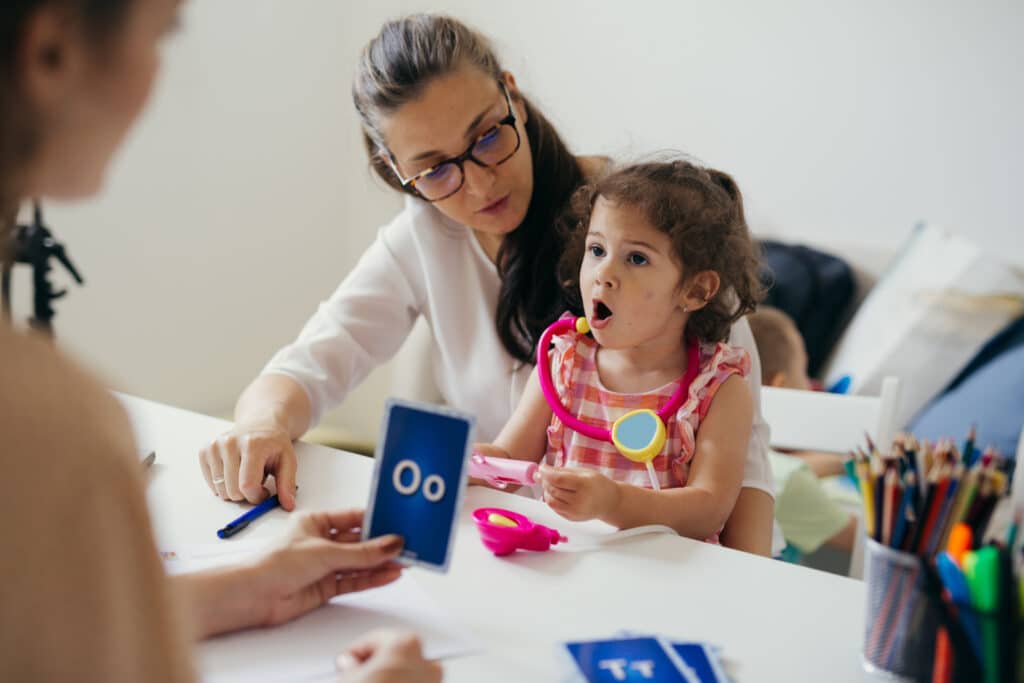The Key to Lasting Progress: Effective Language Goals for Speech Therapy

Written by: Michelle Altamura, MS CCC-SLP TSSLD
Introduction to Language Goals in Speech Therapy
When supporting children with communication needs, setting clear and measurable language goals for speech therapy is essential. Effective therapy goes beyond fun or engaging activities, it requires a structured plan that keeps sessions purposeful, individualized, and measurable. These goals help map out therapy sessions to allow progress to be tracked over time and to adjust strategies and goals that may not be working.
By defining the direction of intervention and creating accountability across settings, language goals for speech therapy ensure that children are always working toward meaningful outcomes. Because communication connects to every part of a child’s life: school, play, and family interactions, well-written goals provide a solid foundation for growth.
Why Language for Speech Therapy Goals Matter
Language development is the foundation of communication, academic success, and social connection. Without clear goals, therapy can lose focus. Research shows that setting language goals for speech therapy creates a clear direction for intervention and ensures therapy aligns with developmental expectations.
Therapy goals matter because they meet the child at their current level, provide measurable benchmarks to track growth, and guide caregivers in using communication strategies during everyday routines. Families often find comfort in having clear goals—they can see progress, understand the focus of therapy, and participate more actively in their child’s development.
Speech therapy often overlaps with occupational therapy (OT), physical therapy (PT), applied behavior analysis (ABA), and special education (SPED). When goals are aligned across services, children receive more consistent and effective support.
Characteristics of Effective Language Goals
When designing language goals for speech therapy, the wording should be specific, measurable, attainable, and relevant, as well as be able to be met within a specific timeframe. This helps to track and manage the goals for optimal success.
Specificity and Clarity in Goal Setting
For example, a vague goal such as “Improve vocabulary” lacks direction and makes progress difficult to track because it is difficult to know what part of vocabulary is supposed to improve? A more appropriate language goal for speech therapy might state: “Marissa will label 10 common household objects (e.g., cup, chair, ball) during play.” This version works better because it provides measurable evidence of progress, guides intervention planning, and helps both the therapist and family share a mutual understanding of expectations.
Balancing Developmental Appropriateness with Functionality
When creating language goals for speech therapy, clinicians must balance developmental appropriateness with functionality, ensuring goals support meaningful communication in everyday life. A strong goal outlines who is involved, what the child will do, how success will be measured, the routine where the skill will occur, and the “so that” statement explaining why the skill matters. Embedding goals within natural family routines makes them more practical and easier for caregivers to reinforce at home.
Well-written language goals for speech therapy are individualized, reflect family priorities, and use parent-friendly wording. They emphasize functional skills, define observable behaviors, and consider each child’s strengths, needs, and abilities. Goals are evidence-based and meaningful, relevant, and sustainable, leading to greater consistency, stronger carryover, and successful generalization across settings.
Types of Language Goals for Speech Therapy
Language goals should always be individualized, but here are some examples:
Receptive Language Goals
Receptive goals target what a child understands. For instance:
- Following directions: “Marissa will follow two-step directions (e.g., ‘Pick up the block and put it in the box’) during clean-up.”
- Identifying words: “Allison will identify 10 targeted vocabulary items (objects, actions, or concepts) during structured play.”
Expressive Language Goals
Expressive goals target what a child says. Examples include:
- Combining words: “Rebecca will independently produce 2–3-word combinations (e.g., ‘want ball,’ ‘go car’) during structured and unstructured play.”
- Expanding vocabulary: “Paul will expand semantic categories by labeling at least 15 new words across categories such as foods, animals, and transportation.”
Pragmatic (Social) Language Goals
These goals support social interactions:
- “Risa will initiate peer interactions by using greetings or requests (e.g., ‘hi,’ ‘play ball’) during free play.”
- “Alex will take turns during conversation or play activities.”
Syntax and Morphology Goals
These focus on helping children use words correctly in sentences:
- “Sam will apply grammatical morphemes such as adding -s to make words plural (e.g., dogs, cars).”
- “Anthony will use regular and irregular past tense verbs (e.g., played, ran) in sentences.”
Functional Communication Goals
These goals emphasize real-world communication:
- “Allen will request help appropriately during mealtime and dressing (e.g., ‘help me,’ ‘open please’).”
- “Tray will use his communication device or pointing to request at least 5 foods during mealtime.”
All goals should be individualized for each child. A toddler with limited speech may start with receptive and expressive goals, while an older child might benefit more from pragmatic or functional communication goals. What matters is that each goal reflects the child’s strengths, needs, and family priorities.
The Role of Family Collaboration in Achieving Language Goals
Family involvement is key to success. Children use language most often in natural settings during meals, playtime, story time, or daily routines like brushing teeth. Embedding therapy goals into these moments ensures more practice and better carryover. For example: “During dinner, the child will request food items using two-word phrases (e.g., ‘more juice’) with verbal prompts as needed.” When families understand and participate in creating therapy goals, they become active participants in the child’s therapy.
Monitoring and Adjusting Language Goals for Speech Therapy
Progress in speech therapy is rarely a straight line. Some children master skills quickly; others take more time. This is why ongoing monitoring is essential and should be tracked by considering therapy data, caregiver and teacher feedback, and observations of how the child communicates during everyday routines. When these pieces are viewed together, they provide a clear picture of whether language goals for speech therapy remain realistic, meaningful, and aligned with the child’s needs.
If progress slows, it does not mean the goal is wrong. Often, it means the approach may need to shift. The therapist may break the goal into smaller steps, add supports such as visual cues or extra modeling, or create more practice opportunities.
Flexibility is crucial. Language goals for speech therapy should grow and evolve as a client develops new skills. This might include making goals more challenging, changing the level of support required in the goal, shifting focus to functional communication skills for daily life, or replacing goals that no longer works for the client. By continuously adjusting goals, therapy remains individualized, responsive, and effective, ensuring meaningful progress that carries over outside of therapy.
Conclusion: Achieving Success with Language Goals in Speech Therapy
Setting effective language goals for speech therapy involves planning, evidence-based strategies, and collaboration with clients and their families. When goals are functional and individualized, they foster communication growth that extends well beyond the therapy room. Thoughtfully designed goals not only make therapy more effective but also empower families to support their child’s progress in natural environments—leading to stronger carryover and long-term success.
At Achieve Beyond, our speech-language pathologists (SLPs) design personalized, parent-friendly goals that connect with daily routines. We also collaborate closely with our multidisciplinary team, including ABA providers, occupational therapists (OTs), physical therapists (PTs), and special education teachers—so that every child receives consistent, holistic support.
Share this blog
Categories
Recent Blog Posts
-
Autism Acronyms and Terms Made Simple: A Parent’s Guide from Achieve Beyond
-
Early Intervention Speech Therapy Evaluation: What to Expect and How to Prepare
-
The Key to Lasting Progress: Effective Language Goals for Speech Therapy
-
What is Shaping in Applied Behavior Analysis: Small Steps to Big Change
-
Reimagining Phonological Therapy with the Complexity Approach




